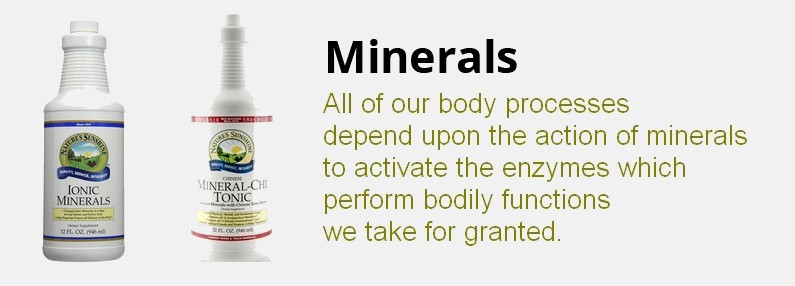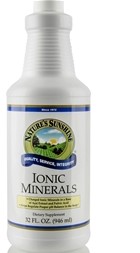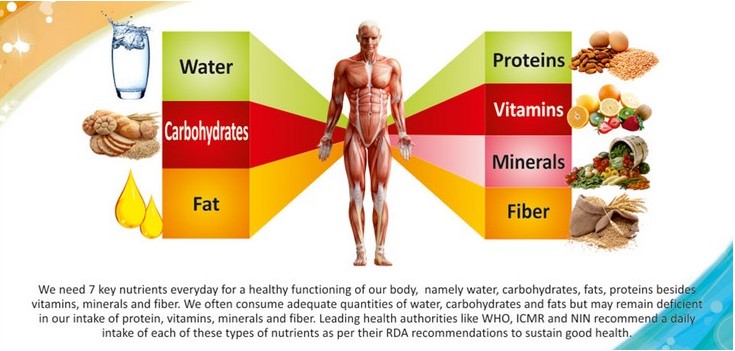

Trace Minerals:
The Most Important Supplements
Did you know?
Liquid Trace Minerals or LTMs and electrolyte ionic minerals increase the body's electrical energy flow and are sometimes called "the spark of life".
Minerals, especially trace minerals, are essential to cellular and glandular metabolism. A lack of minerals causes glandular imbalances and fatigue.
Enzymes are activated by trace minerals
Minerals combine with enzymes to eliminate toxic cellular waste. Hence, minerals are great detoxifiers, especially to the liver.
Every enzyme system has a mineral that triggers it, hence, enzyme systems can shut down when the trace mineral they require is lacking. Enzymes run all of our life processes.
Many people take a multiple vitamin and mineral supplement every day and for most people, it’s probably a good practice because of the many refined and
processed foods they eat. However, you could get most of these nutrients by eating a well-balanced diet of natural foods.
There is one group of nutrients that is difficult to get enough of, even in the
best of diets. We are speaking of trace minerals. Our agricultural practices
have greatly reduced the availability of these nutrients in food. Hence, no
matter how good your diet, it is probably still deficient in trace minerals.
With their positive and negative electrical charges, minerals are responsible
for every electrochemical reaction in the human body. From the firing of the
neurotransmitters in the brain to cellular metabolism, minerals are essential
to life itself! We are literally composed of the “dust of the earth,” i.e., minerals.
To quote Linus Pauling, winner of two Nobel Prizes, “You can trace every
sickness, every disease and every ailment to a mineral deficiency.”
That’s why a trace mineral supplement is probably the most important
supplement you can take. It is even more important than vitamins.
Minerals from Aluminum to Zinc
There are two types of minerals: macro minerals and trace minerals.
** Macro
minerals are needed in greater amounts by the body and they include calcium,
magnesium, phosphorus, potassium, sodium, and sulfur.
** Trace minerals are
just as essential but are needed in lesser amounts by the body.
You have probably heard of some of the more well-known trace minerals,
such as zinc, chromium, copper, iron, boron, selenium and silicon. However,
there are other minerals that are needed in extremely tiny amounts in the body,
including some toxic elements. We’re talking about aluminum, bismuth, cobalt,
germanium, gold, lithium, molybdenum, nickel, silver and vanadium.
Beyond this are a host of minerals that are present in our food and water in
tiny amounts, but we have yet to discover their function, if any, in the body.
These include barium, cesium, dysprosium, hafnium, holmium, iridium,
palladium, platinum, rhodium, tellurium, titanium, tungsten, and zicronium.
Some nutritionists believe that every element in the periodic table may be
needed in the body in some tiny amount. However, all of these minerals must
be presented to the body in the proper form or they cannot be properly utilized.
In the wrong form, many of these elements are even toxic.
The safest way to ensure you are getting all of the trace minerals your body
needs is to take a colloidal suspension of minerals, commonly called Ionic
Minerals. We prefer to refer to them as Liquid Trace Minerals or LTM’s.

The Best Way to Eat a Rock?
There is a lot of confusion in the
marketplace about mineral supplements.
Let’s see if we can help clear
things up.
Living tissues utilize minerals in
ionic form, that is, as single mineral
atoms. These single atoms of a mineral
are bonded to an organic molecule
such as an enzyme or protein.
This is how minerals are presented to
our body in foods.
Minerals in the earth are not found
in ionic form. In their raw form minerals
exist primarily as metals or
salts. That’s why we can’t get our
minerals by eating rocks. However,
small amounts finely ground raw minerals
can be assimilated by our bodies.
When ingested, our digestive secretions
break ions off of the surface of
the salt or metal. These ions are then
attached to amino acids from the proteins
in our food and transported into
the body.
Metallic minerals and salts are the
cheapest, but most ineffective forms
of mineral supplementation. They
are poorly absorbed and tend to irritate
the intestinal lining.
The most commonly used metallic
supplement is finely ground iron filings.
We all know what metals are
like. Can you imagine how indigestible
they are? Yet, metallic iron is
added to cold breakfast cereals.
Many salt forms of minerals are
found in supplements, too. Examples
of salt forms of minerals include calcium
carbonate, ferrous sulfate, potassium
carbonate and zinc sulfate.
Chelates
In order to improve the absorption
of minerals scientists have learned to
chelate minerals. This is done to try to “predigest” the mineral.
Ionic forms
of minerals are bonded to an organic
acid such as a citrate or amino acid.
This is referred to as chelation.
Gluconates, citrates and glycerophosphates
are all examples of chelated
minerals. Unfortunately, most
of these minerals form such strong
bonds that it is difficult for the digestive
tract to break them apart. Hence,
they don’t fare much better than salts
as far as absorption is concerned.
The exception to this is amino acid
chelates, which are essentially predigested
minerals ready for absorption.
The only true amino acid chelates are
produced by a company in Utah. This
form of mineral is found in Target TS-II. The only disadvantage
to this form of mineral supplementation
is that it is expensive.
Colloids
The term colloid
refers to a liquid
suspension
where the suspended particles are so
tiny that they tend to stay in solution
permanently rather than settle out.
This is the form of minerals presented
to the body when a person drinks mineral water.
We stress that this is a liquid form
of mineral because there are companies
claiming to sell “dried” colloidal
minerals. This is impossible, since
drying a colloid would return it to a
salt form. There is no such thing as a “dried” colloidal suspension.
The advantage of colloids is their
small particle size. The minute particles
expose more surface area of the
mineral to the action of digestive secretions.
To help you understand this, imagine
you have a cube of iron one inch
square. The total surface area of this
cube would be six square inches. If this cube of iron were dissolved into a
colloidal suspension, the particles
would become so tiny that they would
be invisible. However, the surface
area would be something in the neighborhood
of 127 acres.
The electrical charge is on the surface
of the mineral, so a colloidal suspension
has a greater energy charge
(and hence a greater ability to interact
with living tissue) than a salt or metallic
form of a mineral.
One of the biggest advantages of a
colloidal mineral is the fact that
it contains such a wide spectrum of minerals.
This, coupled with the fact that
they are relatively easier to assimilate
and less prone to toxicity or intestinal
irritation than metals or salts,
makes them an ideal way to “eat your
rocks.”
 Liquid Trace
Minerals
Liquid Trace
Minerals
The North American Indians had
legends about healing springs which
gave rise to the myths about fountains
of youth. The experience of a
southern Utah rancher suggests that
these “fountains of youth” may have
been mineral springs. When the
rancher developed certain health
problems, an Indian ranch hand told
him that there was a sacred spring on
his property that the Indians had
used for healing purposes. Together,
they found the spring and the rancher
bottled up the water and drank it. His
health problems disappeared. He
gave the water to others and it seemed
to help them as well.
Eventually, he invited a geologist
to examine the spring and it was
determined that the spring ran over a
deposit a clay deposit which contained
prehistoric plant material. As the
water trickled over the clay, it picked
up some 60 different trace minerals.
After some experimentation, the
rancher developed a “cold extraction” process which produced a super saturated
mineral water. This was the
first product of this type on the market,
although other people have created
similar products since that time.
The raw clay from various deposits in
southern Utah has also been sold in
bulk and tablet form. Montmorillonite
is one form of this clay which is
sold in tablets as Mineral Maintenance.
Because these LTMs and clays contain
toxic minerals like aluminum,
some people have argued that they
must be toxic. However, both the
clays and the mineral waters have
been fed to animals, plants and human
beings for over 50 years with no
sign of toxicity. (And remember that
the mineral springs they are derived
from have been in use for thousands of
years before that.) Hence, the colloidal
form of these minerals renders
them essentially nontoxic. (Theoretically
anything is toxic in high enough
amounts.)
There are 64 macro and trace minerals
in NSP’s Ionic Trace Minerals. Ionic
minerals also form the base for Chinese Mineral Chi Tonic. If you
don’t like the taste of these products
straight, try taking them in your favorite
juice. Many people find they
acquire a taste for these products because
of their health benefits.

This information is for educational purposes
only. Consult with a qualified
health practictioner for all serious or
persistant illness.
Copyright © 1999 by Robinson & Horne,
L.C., P.O. Box 1028, Roosevelt, UT
84066.
This material
may be printed from this database (in
single copies only) for educational purposes
only (not for resale) provided it is
not altered in any way.
Distributed by: Four Winds Nutrition and Webnat.com
Things to know..
Frequent mouth wounds are caused by a lack of iron, folic acid and vitamin B12 from your body.
Dried lips, even cracked are the symptoms of the lack of vitamin B2 and vitamin B6.
A reddish skin, irritated on the hands and legs are determined by the lack of some of the B vitamin complex, vitamin E and other essential acids.
Eczemas and dried skin are the symptoms of a lack of zinc and fatty acids.
If you are a woman who suffers from a very bad PMS syndrome you should try eating foods more rich in zinc, magnesium and vitamin B6.
A slow growing hair is the sign of a lack of iron and zinc.
Red eyes and tired eyes are due to a lack of vitamin A and vitamin B2 form the body.
The exfoliation of the nails are the symptom of the lack of iron, zinc and fatty acids from the body.
A pale complexion and anemia can be a symptom of the lack of iron, folic acid and vitamin B12.
If you are feeling tired all the time you should try eating more fresh foods. Avoid eating highly processed foods for a while and eat fresh fruits and vitamins.
Zits are a sign of the lack of vitamin A, fatty acids and zinc.
Phosphorus - Lack of phosphorus causes weakening of the bones and teeth, and loss of weight.
Potassium - The deficiency of potassium may cause weakness of the muscles, even paralysis. It may also cause brittleness of the bones, sterility and heart ailments.
Sulphur - Some metabolic processes in the body are hindered by a deficiency of sulphur.
Iodine - Lack of iodine impairs the function of the thyroid gland, resulting in goiter.
Magnesium - Bones, teeth and muscles weaken due to the deficiency of magnesium. Insufficient supply of magnesium may even give rise to heart ailments.
|